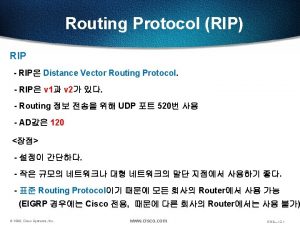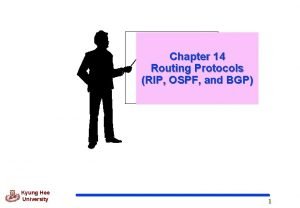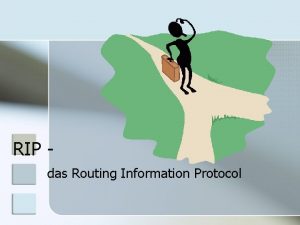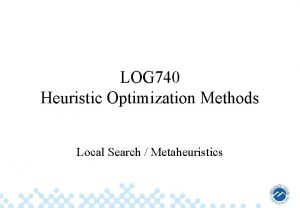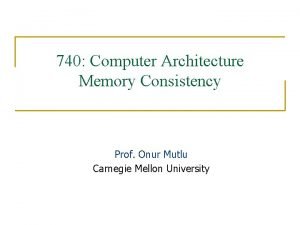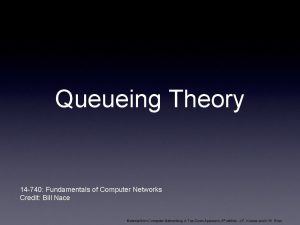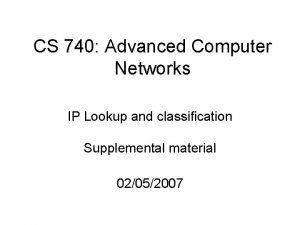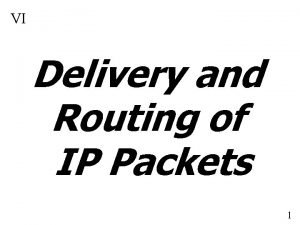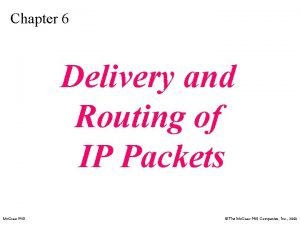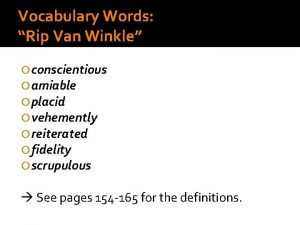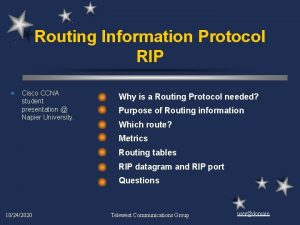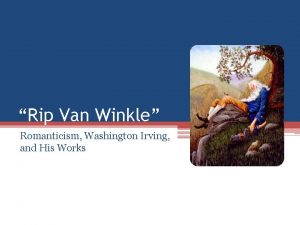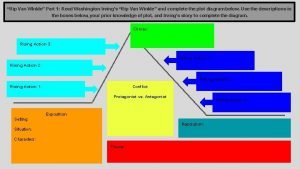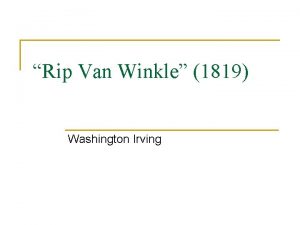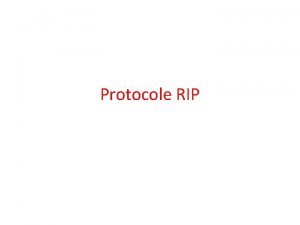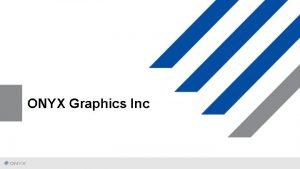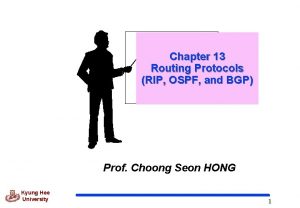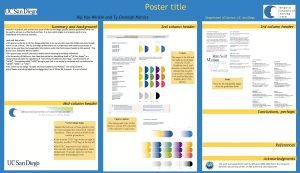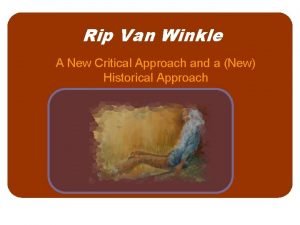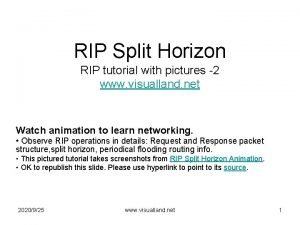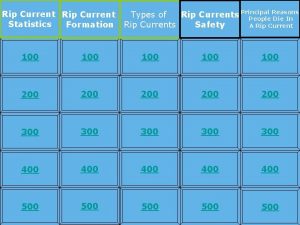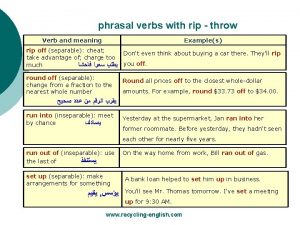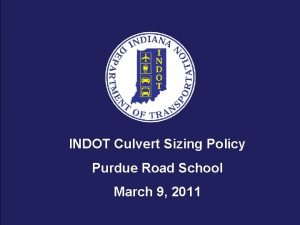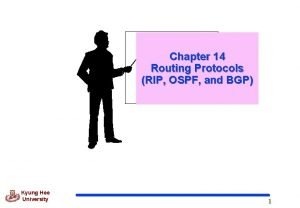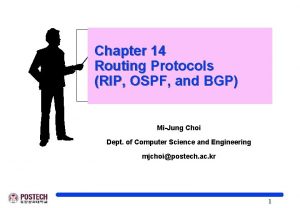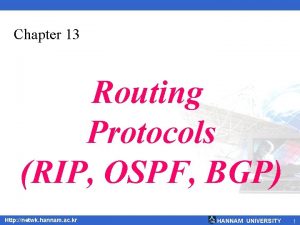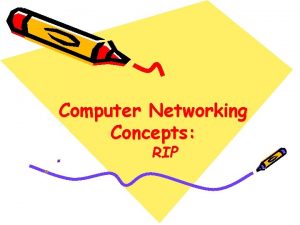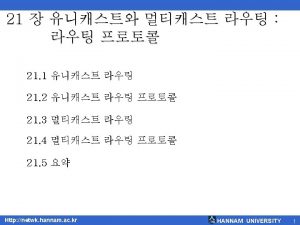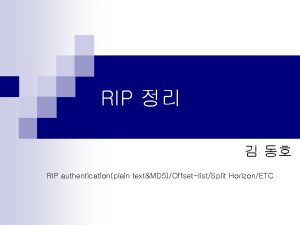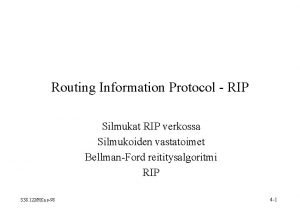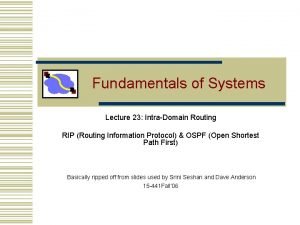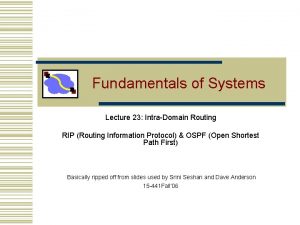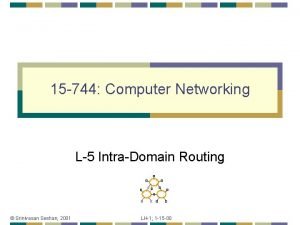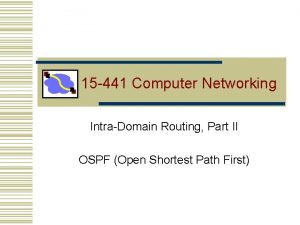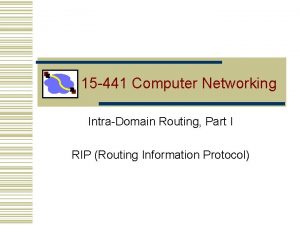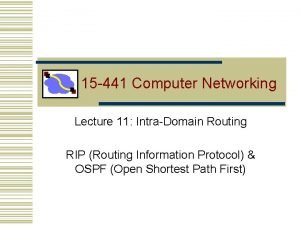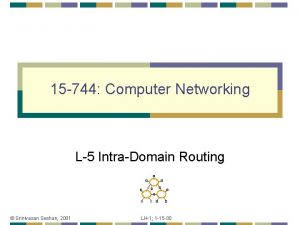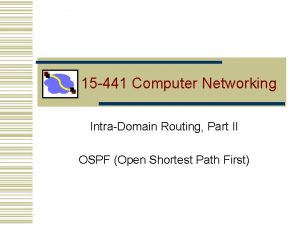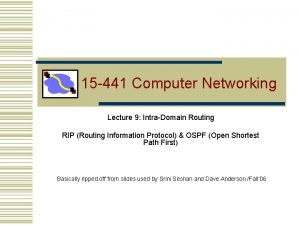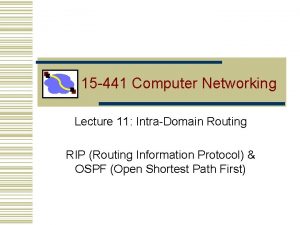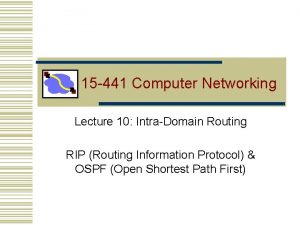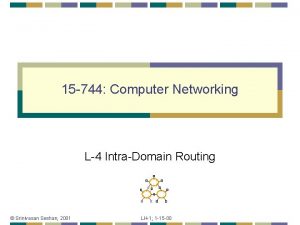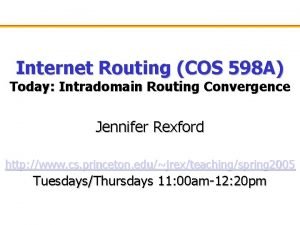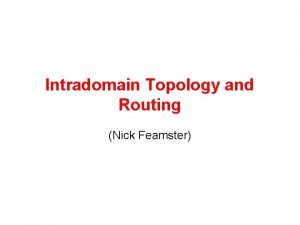14 740 Networking IntraDomain Routing RIP Routing Information
















































- Slides: 48

14 -740: Networking Intra-Domain Routing RIP (Routing Information Protocol) & OSPF (Open Shortest Path First)

IP Forwarding • The Story So Far… • IP addresses are structured to reflect Internet structure Router • IP packet headers carry these addresses • When Packet Arrives at Router • Examine header to determine intended destination • Look up in table to determine next hop in path • Send packet out appropriate port • This/next lecture • How to generate the forwarding table 2

Graph Model • Represent each router as node • Direct link between routers represented by edge • Symmetric links undirected graph • Edge “cost” c(x, y) denotes measure of difficulty of using link • delay, $ cost, or congestion level • Task • Determine least cost path from every node to every other node • Path cost d(x, y) = sum of link costs E 3 C 1 1 F 2 6 1 A 3 4 D 3 B

Routes from Node A Forwarding Table for A Dest Cost Next Hop A 0 A B 4 B C 6 E D 7 B E 2 E F 5 E E 3 C 1 1 F 2 6 1 A D 3 4 B • Properties • Some set of shortest paths forms tree • Shortest path spanning tree • Solution not unique • E. g. , A-E-F-C-D also has cost 7 4

• Ways to Compute Shortest Paths Centralized • Collect graph structure in one place • Use standard graph algorithm • Disseminate routing tables • Link-state • Every node collects complete graph structure • Each computes shortest paths from it • Each generates own routing table • Distance-vector • No one has copy of graph • Nodes construct their own tables iteratively • Each sends information about its table to neighbors 5

Outline • Distance Vector • Link State • Routing Hierarchy 6

Distance-Vector Method Initial Table for A • Idea Dest Cost Next Hop A 0 A B 4 B C – D – E 2 E F 6 F E 3 C 1 1 F 2 6 1 A 3 4 D B • At any time, have cost/next hop of best known path to destination • Use cost when no path known • Initially • Only have entries for directly connected nodes 7

Distance-Vector Update z d(z, y) c(x, z) y x d(x, y) • Update(x, y, z) d c(x, z) + d(z, y) # Cost of path from x to y with first hop z if d < d(x, y) # Found better path return d, z # Updated cost / next hop else return d(x, y), nexthop(x, y) # Existing cost / next hop 8

Algorithm • Bellman-Ford algorithm • Repeat For every node x For every neighbor z For every destination y d(x, y) Update(x, y, z) • Until converge 9

Start Optimum 1 -hop paths Table for A E Table for B Dst Cst Hop A 0 A A 4 A B 4 B B 0 B C – D – D 3 D E 2 E E – F 6 F F 1 F Table for C 3 C 1 1 F 2 6 1 A 3 4 D B Table for D Table for E Table for F Dst Cst Hop A – A 2 A A 6 A B – B 3 B B – B 1 B C 0 C C 1 C C – C 1 C D 1 D D 0 D D – E – E 0 E E 3 E F 1 F F – F 3 F F 0 F 10

Iteration #1 Optimum 2 -hop paths Table for A E Table for B Dst Cst Hop A 0 A A 4 A B 4 B B 0 B C 7 F C 2 F D 7 B D 3 D E 2 E E 4 F F 5 E F 1 F Table for C 3 C 1 1 F 2 6 1 A D 3 4 B Table for D Table for E Table for F Dst Cst Hop A 7 F A 7 B A 2 A A 5 B B 2 F B 3 B B 4 F B 1 B C 0 C C 1 C C 4 F C 1 C D 1 D D 0 D D – D 2 C E 4 F E – E 0 E E 3 E F 1 F F 2 C F 3 F F 0 F 11

Iteration #2 Optimum 3 -hop paths Table for A E Table for B Dst Cst Hop A 0 A A 4 A B 4 B B 0 B C 6 E C 2 F D 7 B D 3 D E 2 E E 4 F F 5 E F 1 F Table for C 3 C 1 1 F 2 6 1 A D 3 4 B Table for D Table for E Table for F Dst Cst Hop A 6 F A 7 B A 2 A A 5 B B 2 F B 3 B B 4 F B 1 B C 0 C C 1 C C 4 F C 1 C D 1 D D 0 D D 5 F D 2 C E 4 F E 5 C E 0 E E 3 E F 1 F F 2 C F 3 F F 0 F 12

Distance Vector: Link Cost Changes Link cost changes: • Node detects local link cost change • Updates distance table • If cost change in least cost path, notify neighbors “good news travels fast” 1 X 4 Y 50 1 Z algorithm terminates 13

Distance Vector: Link Cost Changes Link cost changes: • Good news travels fast • Bad news travels slow “count to infinity” problem! 60 X 4 Y 50 1 Z algorithm continues on! 14

Distance Vector: Split Horizon If Z routes through Y to get to X : • Z does not advertise its route to X back to Y 60 X 4 Y 1 50 Z algorithm terminates ? ? ? 15

Distance Vector: Poison Reverse If Z routes through Y to get to X : • • • Z tells Y its (Z’s) distance to X is infinite (so Y won’t route to X via Z) Immediate notification of unreachability, rather than split horizon timeout waiting for advertisement Will this completely solve count to infinity problem? 60 X 4 Y 50 1 Z algorithm terminates 16

Poison Reverse Failures Table for A Table for B Table for D Table for F Dst Cst Hop C 7 F C 8 A C 9 B C 1 C Table for A Dst Cst Hop C – Table for F Forced Update Dst Cst Hop C – Table for A Dst Cst Hop C 13 D Forced Update Better Route A Hop C 14 A Forced Update Table for A Dst Cst Hop C 19 D 1 Table for B Cst Forced Update • • • C 1 4 Dst F 6 1 B D Table for D Dst Cst Hop C 15 B • Iterations don’t converge • “Count to infinity” • Solution • Make “infinity” smaller • What is upper bound on maximum path length? 17

• Routing Information Protocol (RIP) (1982 BSD) Earliest IP routing protocol • Current standard is version 2 (RFC 1723) • Features • Every link has cost 1 • “Infinity” = 16 • Limits to networks where everything reachable within 15 hops • Sending Updates • Every router listens for updates on UDP port 520 • RIP message can contain entries for up to 25 table entries 18

• Initial RIP Updates • When router first starts, asks for copy of table for every neighbor • Uses it to iteratively generate own table • Periodic • Every 30 seconds, router sends copy of its table to each neighbor • Neighbors use it to iteratively update their tables • Triggered • When every entry changes, send copy of entry to neighbors • Except for one causing update (split horizon rule) • Neighbors use it to update their tables 19

RIP Staleness / Oscillation • Small Infinity Control • Count to infinity doesnt take very long • Route Timer • Every route has timeout limit of 180 seconds • Reached when haven’t received update from next hop for 6 periods • If not updated, set to infinity • Soft-state refresh important concept! • Behavior • When router or link fails, can take minutes to stabilize 20

Outline • Distance Vector • Link State • Routing Hierarchy 21

Link State Protocol Concept • Every node gets complete copy of graph • Every node “floods” network with data about its outgoing links • Every node computes routes to every other node • Usingle-source, shortest-path algorithm • Process performed whenever needed • When connections die / reappear 22

Sending Link States by Flooding • X Wants to Send Information. X • Sends on all outgoing links • When Node Y Receives Information from Z • Send on all links other than Z C A B D X A C B (a) X A C B (c) D (b) D X A C B (d) 23 D

Dijkstra’s Algorithm • Given • Graph with source node s and edge costs c(u, v) • Determine least cost path from s to every node v • Shortest Path First Algorithm • Traverse graph in order of least cost from source 24

Dijkstra’s Algorithm: Concept E 2 3 C 1 5 2 F 2 Current Path Costs 6 Source Node 1 0 A 3 3 3 D B Done Unseen Horizon • Node Sets • Done • Already have least cost path to it • Horizon: • Reachable in 1 hop from node in Done • Unseen: • Cannot reach directly from node in Done • Label • d(v) = path cost from s to v • Path • Keep track of last link in path 25

Dijkstra’s Algorithm: Initially E 3 C 1 2 F 2 Current Path Costs 6 Source Node 1 0 A Horizon Done 3 3 D B Unseen • No nodes done • Source in horizon 26

Dijkstra’s Algorithm: Initially E 2 3 C 1 6 2 F 2 Current Path Costs 6 Source Node 1 0 A 3 3 3 D B Done Horizon Unseen • d(v) to node A shown in red • Only consider links from done nodes 27

Dijkstra’s Algorithm E 2 3 C 1 5 6 Current Path Costs 2 F 2 6 Source Node 1 0 A 3 3 3 D B Done Unseen Horizon • Select node v in horizon with minimum d(v) • Add link used to add node to shortest path tree • Update d(v) information 28

Dijkstra’s Algorithm Horizon E 2 3 C 1 5 Current Path Costs 2 F 2 6 Source Node 1 0 A Done 3 3 3 D B Unseen • Repeat… 29

Dijkstra’s Algorithm E 2 3 C 1 4 Current Path Costs 2 F 2 Unseen 6 Source Node 1 0 A Done 3 3 B D 3 6 Horizon • Update d(v) values • Can cause addition of new nodes to horizon 30

Dijkstra’s Algorithm E 2 3 C 1 4 2 F 2 5 6 Source Node 1 0 A 3 3 3 D 6 B • Final tree shown in green 31

Link State Characteristics • With consistent LSDBs*, all nodes compute consistent loop-free paths • Can still have transient loops *Link State Data Base B 1 A X 1 3 5 C 2 D Packet from C A may loop around BDC if B knows about failure and C & D do not 32

OSPF Routing Protocol • Open standard created by IETF • Shortest-path first • Another name for Dijkstra’s algorithm • More prevalent than RIP 33

OSPF Reliable Flooding • Transmit link state advertisements • Originating router • Typically, minimum IP address for router • Link ID • ID of router at other end of link • Metric • Cost of link • Link-state age • Incremented each second • Packet expires when reaches 3600 • Sequence number • Incremented each time sending new link information 34

OSPF Flooding Operation • Node X Receives LSA from Node Y • With Sequence Number q • Looks for entry with same origin/link ID • Cases • No entry present • Add entry, propagate to all neighbors other than Y • Entry present with sequence number p < q • Update entry, propagate to all neighbors other than Y • Entry present with sequence number p > q • Send entry back to Y • To tell Y that it has out-of-date information • Entry present with sequence number p = q • Ignore it 35

Flooding Issues • When should it be performed • Periodically • When status of link changes • Detected by connected node • What happens when router goes down & back up • Sequence number reset to 0 • Other routers may have entries with higher sequence numbers • Router will send out LSAs with number 0 • Will get back LSAs with last valid sequence number p • Router sets sequence number to p+1 & resends 36

Adoption of OSPF • RIP viewed as outmoded • Good when networks small and routers had limited memory & computational power • OSPF Advantages • Fast convergence when configuration changes 37

Comparison of LS and DV Message complexity • LS: with n nodes, E links, O(n. E) Space requirements: • LS maintains entire topology messages • DV maintains only neighbor state • DV: exchange between neighbors only Robustness: router malfunctions Speed of Convergence • LS: Node can advertise incorrect link cost • LS: Relatively fast • Each node computes its own table • Complex computation, but can forward before computation • DV: Node can advertise incorrect path cost • may have transient loops • DV: convergence time varies • Each node’s table used by others (error propagates) • may have routing loops • count-to-infinity problem • faster with triggered updates 38

Outline • Distance Vector • Link State • Routing Hierarchy 39

Routing Hierarchies • Flat routing doesn’t scale • Storage Each node cannot be expected to store routes to every destination (or destination network) • Convergence times increase • Communication Total message count increases • Key observation • Need less information with increasing distance to destination • Need lower diameters networks • Solution: area hierarchy 40

Areas • Divide network into areas • Areas can have nested sub-areas • Hierarchically address nodes in a network • Sequentially number top-level areas • Sub-areas of area are labeled relative to that area • Nodes are numbered relative to the smallest containing area 41

Routing Hierarchy Area-Border Router Backbone Areas Lower-level Areas • Partition Network into “Areas” • Within area • Each node has routes to every other node • Outside area • Each node has routes for other top-level areas only • Inter-area packets are routed to nearest appropriate border router 42 • Constraint: no path between two sub-areas of an area can exit that area

Area Hierarchy Addressing 1 2 2. 1 1. 1 2. 2. 1 1. 2. 2 3 3. 1 3. 2 43

Path Sub-optimality • Can result in sub-optimal paths 1 2 2. 1 1. 1 2. 2. 1 1. 2. 1 start end 3. 2. 1 3 3 hop red path vs. 2 hop green path 3. 1 3. 2 44

Next Lecture: BGP • How to connect together different ISPs 45

RIP Table Processing • RIP routing tables managed by applicationlevel process called route-d (daemon) • advertisements sent in UDP packets, periodically repeated 47

Dijsktra’s Algorithm 1 Initialization: 2 N = {A} 3 for all nodes v 4 if v adjacent to A 5 then D(v) = c(A, v) 6 else D(v) = infinity 7 8 Loop 9 find w not in N such that D(w) is a minimum 10 add w to N 11 update D(v) for all v adjacent to w and not in N: 12 D(v) = min( D(v), D(w) + c(w, v) ) 13 /* new cost to v is either old cost to v or known 14 shortest path cost to w plus cost from w to v */ 15 until all nodes in N 48

Dijkstra’s algorithm: example Step start N D(B), p(B) D(C), p(C) D(D), p(D) D(E), p(E) D(F), p(F) 5, A 1, A infinity 2, A 0 A infinity 4, D 2, A 1 AD infinity 3, E 2, A 2 ADE 4, E 3 ADEB 4, E 4 ADEBC 4, E 5 ADEBCF 5 2 A B 2 1 D 3 C 3 1 5 F 1 E 2 49
 Rip meaning in networking
Rip meaning in networking Sdn overview
Sdn overview Stub link
Stub link Rip routing tabelle
Rip routing tabelle Flood routing meaning
Flood routing meaning Static routing and dynamic routing
Static routing and dynamic routing Continuity equation hydrology
Continuity equation hydrology Routing in physical design
Routing in physical design Asc 740
Asc 740 Fas 109 and fin 48
Fas 109 and fin 48 Asc 740 training
Asc 740 training 740
740 Gabriel deloitte
Gabriel deloitte Onur mutlu computer architecture
Onur mutlu computer architecture Who wrote the ffa creed? when was it adopted?
Who wrote the ffa creed? when was it adopted? 14-740
14-740 F 740
F 740 R 740
R 740 Cs 740
Cs 740 Information centric networking
Information centric networking Routing table contains information entered manually
Routing table contains information entered manually Routing table contains information entered manually
Routing table contains information entered manually Pedantic diction
Pedantic diction Ripdates
Ripdates Washington irving romanticism
Washington irving romanticism Rip van winkle class 5 ppt
Rip van winkle class 5 ppt Plot diagram of rip van winkle
Plot diagram of rip van winkle Why does rip van winkle experience a crisis in identity?
Why does rip van winkle experience a crisis in identity? Difference between dynamic and static routing
Difference between dynamic and static routing Rip ocean fm
Rip ocean fm Routage
Routage Rip onyx
Rip onyx Cross cut vs rip cut blade
Cross cut vs rip cut blade Rip ospf bgp
Rip ospf bgp Transfer rip
Transfer rip Rip curl 1969
Rip curl 1969 Rip van winkle poster
Rip van winkle poster Arie rip
Arie rip Rip van winkle essay
Rip van winkle essay Rip tutorial
Rip tutorial Rip current formation
Rip current formation Rip phrasal verb
Rip phrasal verb Indot frequency manual
Indot frequency manual Rip ospf bgp
Rip ospf bgp Distance-vector routing
Distance-vector routing Rip, ospf, bgp
Rip, ospf, bgp Hop count
Hop count Rip van winkle nature
Rip van winkle nature Rip table
Rip table
